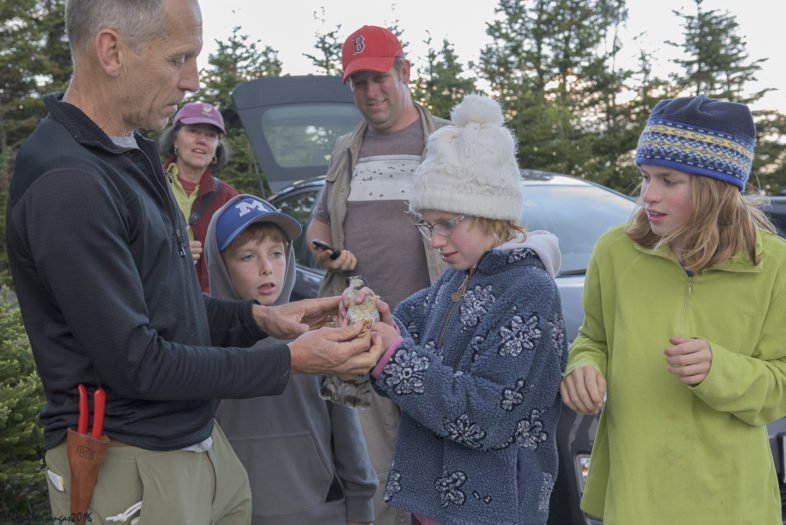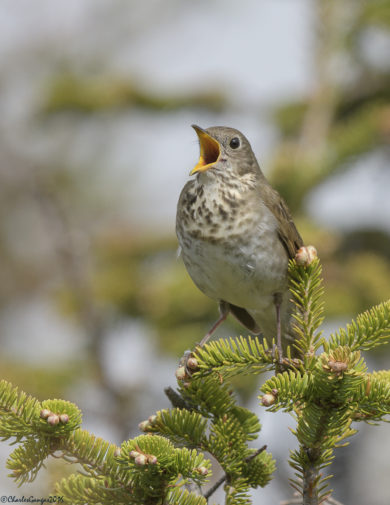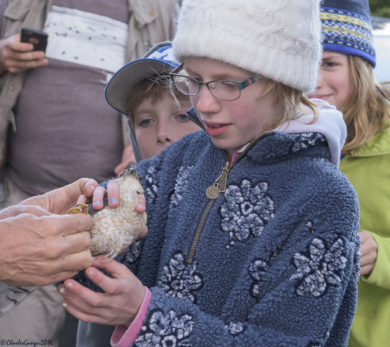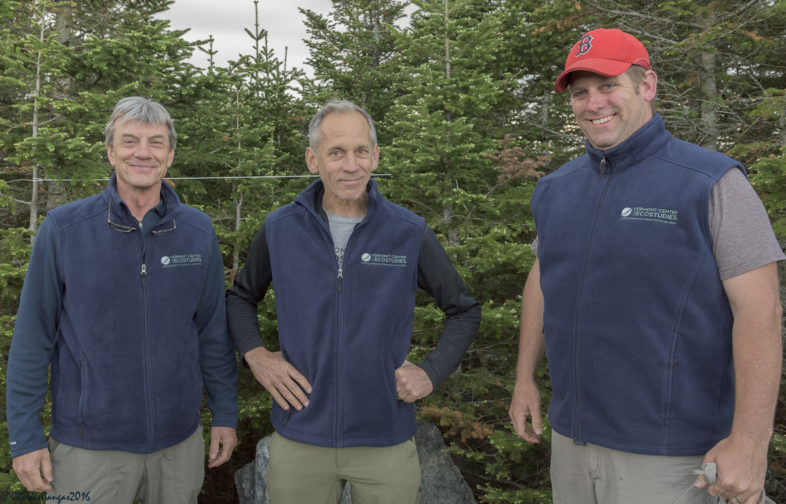
All eyes are intent on a banded Sharp-shinned Hawk prior to release. Photo courtesy of Chuck Gangas.
After a stretch during which Mansfield’s weather was fit for neither bird or beast (humans anyway), VCE returned to our long-term study site on June 15, after a 2-week hiatus. Last week’s field trip was scuttled by the polar express that saw wind chills of 14 degrees F on the ridgeline.

A male Bicknell’s Thrush in full song on the Mansfield ridgeline. Photo courtesy of Chuck Gangas.
Brendan Collins, Steve Faccio, Susan Hindinger and I arrived on the ridgeline in early evening to mostly clear skies, but a brisk northwest wind. Other than American Robins, of which 4 were singing robustly within earshot of the parking lot, we heard few birds. We fanned out and set 27 nets, mainly on the Amherst, Long and Lakeview trails. Our first capture was a Yellow-bellied Flycatcher, second a Swainson’s Thush. Although we were treated to a spectacular sunset, with the Nose positively glowing, the dusk chorus was subdued. I don’t think I’ve ever heard so few Bicknell’s Thrush (BITH) singing and calling on Mansfield in mid-June. Even the White-throats were muted. A few BITH let loose with brief flight songs as darkness fell, but with far less intensity than 2 weeks ago.
The wind dropped overnight, and we were back on the ridgeline shortly after 4 am to open nets. The dawn chorus continued evening’s uninspired trend, with robins again a notable exception. This weak vocalizing may have been partly an artifact of timing, as early-nesting robins are likely tending nestlings, while other species are still incubating, or even building (we caught one female Swainson’s Thrush with nesting material in the net).

Brooke Hindinger prepares to release a banded Sharp-shinned Hawk, as Quinn Collins and Dory Hindinger watch with interest. Photo courtesy of Chuck Gangas.
An early morning surprise was the recapture of a feisty male Sharp-shinned Hawk, a bird that we banded in 2013 and have now caught in each year since. It’s interesting that this individual has been prowling the ridgeline for at least 4 consecutive summers (one wonders how many BITH he’s fed to nestlings – we recovered a female BITH’s radio transmitter in a Sharpie nest in Underhill several years ago). Further, of the 7 Sharpies we’ve netted in mountaintop forests over the years, all have been male. No wonder, considering the advantage of smaller size when navigating at high speeds through the krummholz!
Despite the ridgeline’s seemingly low vocal activity, by morning’s end we had 53 total captures (including a dozen the previous evening), of which 41 were new bandings or returns from previous years, and 12 recaptures of birds banded earlier this season:
Sharp-shinned Hawk 1 — male banded in 2013, captured every year since
Yellow-bellied Flycatcher 2 — neither bird in obvious breeding condition
Bicknell’s Thrush 6 — 2 new, 4 returns (2 females with full incubation patches)
Swainson’s Thrush 4 — 3 new, one male banded in 2015
Hermit Thrush 1 — yearling female with regressing brood patch, probably a failed breeder
Black-and-white Warbler 1 — female w/regressing brood patch, probably another failed breeder
Magnolia Warbler 1 — male
Blackpoll Warbler 8 — 7 new; one male return originally banded in 2009, so at least 8 years old (possibly our oldest bird on record)
Dark-eyed Junco 3 — all new bandings
White-throated Sparrow 9 — 5 new, 4 birds banded in previous years
Purple Finch 4 — all new birds (2 yearling males, 1 older male, 1 female)
Pine Siskin 1 — free-flying juvenile
We couldn’t help wondering if last week’s harsh weather caused some mortality, either of adult birds or nests, leading to the reduced vocal chorus. However, we found no direct evidence for this. The female Blackpoll Warbler that had nearly completed building her nest on June 1 was now incubating 4 eggs, and the persistently singing male robins almost certainly had active nests. Most netted females of all species showed well-developed incubation or brood patches. So, despite several days of severe weather that must have stressed energy budgets and diminished feeding opportunities, it seems most everyone survived. Life in mountaintop forests is not for the avian faint of heart.

Steve Faccio, Chris Rimmer and Brendan Collins strutting their VCE swag. Photo courtesy of Chuck Gangas.
——
